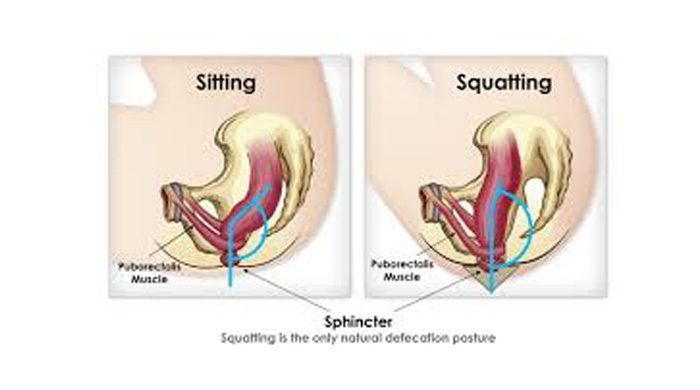Does The Squatty Potty Work? Its All About The Pooping Position

Scientific studies have shown the a squatty stool by itself is ineffective[1], but don’t be so quick to throw it out if you already own one. The use of a squatty potty alone only partially addresses the optimal position for excreting poop. Used correctly it may be helpful, but its use may not be necessary if you use the correct mechanics when pooping.
 There is a bend at the end of the colon of 80-90 degrees, which prevents us from pooping while we walk around.[2] The angle only slightly straightens in the erect sitting position, even while using the squatty potty. The maximal straightening of the bend occurs in the true squatting posture. True squatting straightens anal rectal angle by 90-140 degrees, allowing for easier defecation. This was the natural posture used before the use of toilets.
There is a bend at the end of the colon of 80-90 degrees, which prevents us from pooping while we walk around.[2] The angle only slightly straightens in the erect sitting position, even while using the squatty potty. The maximal straightening of the bend occurs in the true squatting posture. True squatting straightens anal rectal angle by 90-140 degrees, allowing for easier defecation. This was the natural posture used before the use of toilets.
The straightening of the kink in the colon reduces or eliminates straining that can lead to the development of diverticulitis, hemorrhoids, hiatal hernia, and cause the valves of the blood vessels of veins to fail leading to varicose veins.
Since we have been conditioned to poop in toilets, we need to use the best position available on the toilet to maximize the straightening of the colon kink. The key is to bring knees closer to the chest. If you choose to use a squatty poppy it is best to lean forward towards the knees, which will mechanically reposition the anal rectal angle and put pressure on the colon, allowing for a straighter path and easier excretion of of poop.
Don’t worry if you don’t have a squatty stool, you can still straighten out that kink. While sitting on the toilet, move your feet closer to the bowl, lean forward bringing you chest towards your knees, and place your hands on the ground between your legs. This will also straighten the anal rectal angle, put mechanical pressure on the colon, and reduce abdominal strain.
The anal rectal angle is only part of the problem, and the other part is the consumption of low fiber diets that leads to constipation. Straining is caused by passing unnaturally firm stools, and even squatting while passing firm stools does not significantly reduce the pressure than can lead to diverticulitis, hemorrhoids, hiatal hernia, and varicose veins.[3]
The proper pooping position and a plant-based diet produces the maximal anal excretion angle and soft poop that maximizes easy stool elimination.
[1] D Sikirov. Comparison of straining during defecation in three positions: results and implications for human health. Dig Dis Sci. 2003 Jul;48(7):1201-5.
[2] D Raahave. Faecal retention: a common cause in functional bowel disorders, appendicitis and haemorrhoids–with medical and surgical therapy. Dan Med J. 2015 Mar;61(3). pii: B5031.
[3] S S Fedail, R F Harvey, C J Burns-Cox. Abdominal and thoracic pressures during defecation. Br Med J. 1979 Feb 3;1(6159):344.
[4] A Martin, w Odling-Smee. Pressure changes in varicose veins. Lancet. 1976 Apr 10;1(7963):768-70.
Tags: diverticulosis






